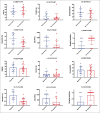Risk of Nephritis and Recurrence in Kimura Disease: A Retrospective Study
- PMID: 38371566
- PMCID: PMC10869022
- DOI: 10.4103/ijd.ijd_670_23
Risk of Nephritis and Recurrence in Kimura Disease: A Retrospective Study
Abstract
Background: Kimura disease (KD) presents a diagnostic challenge to clinicians because of its rarity and atypical symptoms in its early stages, and it is difficult to treat and prone to recurrence or involvement of other organs.
Aims and objectives: This study aims to investigate the possible relevance of renal involvement and recurrence by analysing the clinical presentations, laboratory results, histopathological features, therapeutic data and follow-up results of KD.
Materials and methods: A total of 27 patients diagnosed as KD in two hospitals from January 1999 to December 2021 were analysed retrospectively in this study based on the diagnosis of histopathology.
Results: KD mainly affected male more than female (8:1) with the onset age ranging from 3 to 58 years (median 29.8 years). The common initial symptoms included subcutaneous soft tissue or lymph node enlargement, non-specific skin lesions and proteinuria. One patient presented cough and expectoration as the first symptoms. KD patients often had high levels of serum immunoglobulin E (IgE) and basophils, which exhibited a significantly positive correlation with renal involvement and recurrence (p < 0.05). Early mass resection could prevent the development of nephritis and decrease the risk of relapse (p < 0.05).
Conclusion: KD should be noted in patients presenting with intractable and relapsing atopic skin lesions and (or) subcutaneous mass. Patients with high levels of serum IgE and blood basophils may be prone to developing KD-associated nephritis and predict a high risk of recurrence. Early surgical removal of the mass may result in a better prognosis.
Keywords: Basophils; Kimura disease; nephritis; recurrence; serum IgE.
Copyright: © 2023 Indian Journal of Dermatology.
Conflict of interest statement
There are no conflicts of interest.
Figures




Similar articles
-
The clinicopathological characteristics of Kimura disease in Chinese patients.Clin Rheumatol. 2019 Dec;38(12):3661-3667. doi: 10.1007/s10067-019-04752-6. Epub 2019 Aug 22. Clin Rheumatol. 2019. PMID: 31440918
-
Kimura Disease: A Detailed Analysis of Clinical and Radiological Manifestations in a Retrospective Case Series.J Inflamm Res. 2024 May 23;17:3371-3381. doi: 10.2147/JIR.S462098. eCollection 2024. J Inflamm Res. 2024. PMID: 38803691 Free PMC article.
-
Basophils are increased and express increased levels of interleukin-4 in the parotid lesions of Kimura disease.Asia Pac Allergy. 2017 Oct;7(4):221-226. doi: 10.5415/apallergy.2017.7.4.221. Epub 2017 Oct 23. Asia Pac Allergy. 2017. PMID: 29094020 Free PMC article.
-
Kimura Disease of the Periorbita and Earlobe in a 15-Year-Old Male: A Case Report and Review of the Literature.Ophthalmic Plast Reconstr Surg. 2023 Jan-Feb 01;39(1):26-33. doi: 10.1097/IOP.0000000000002221. Epub 2022 Jun 14. Ophthalmic Plast Reconstr Surg. 2023. PMID: 35699221 Review.
-
Successful treatment of dupilumab in Kimura disease independent of IgE: A case report with literature review.Front Immunol. 2022 Dec 14;13:1084879. doi: 10.3389/fimmu.2022.1084879. eCollection 2022. Front Immunol. 2022. PMID: 36591252 Free PMC article. Review.
Cited by
-
A Stepwise decision tree model for differential diagnosis of Kimura's disease in the head and neck.BMC Med Imaging. 2025 Mar 17;25(1):90. doi: 10.1186/s12880-025-01618-z. BMC Med Imaging. 2025. PMID: 40097945 Free PMC article.
References
-
- Kim HT, Szeto C. Eosinophilic hyperplastic lymphogranuloma, comparison with Mikulicz's disease. J Chin Med. 1937;23:699–700.
-
- Kimura T, Yoshimura S, Ishikawa E. On the unusual granulation combined with hyperplastic changes of lymphatic tissues. Trans Soc Pathol Jpn. 1948;37:179–80.
-
- Lee CC, Feng IJ, Chen YT, Weng SF, Chan LP, Lai CS, et al. Treatment algorithm for Kimura's disease: A systematic review and meta-analysis of treatment modalities and prognostic predictors. Int J Surg. 2022;100:106591. - PubMed
LinkOut - more resources
Full Text Sources
